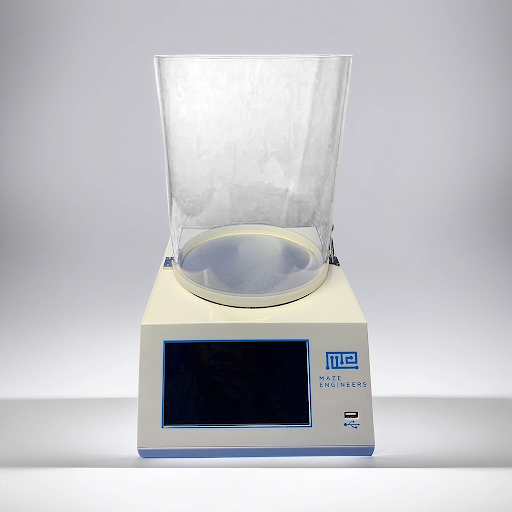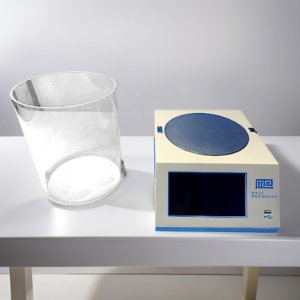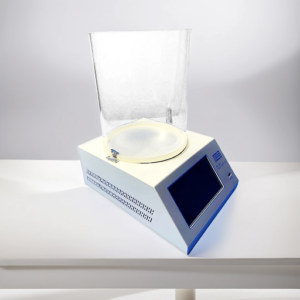Description
The Hot Plate test is a gold standard thermal pain test in rodents and serves as a useful screening tool for interventions of analgesia. The rodent is placed into a chamber with a heated floor with surrounding clear, cylindrical acrylic walls. Upon application of heat, key nocifensive behaviors can be measured such as paw licking and jumping.
The Hot Plate apparatus is composed of a metal temperature plate with a digital display and a lidded transparent glass cylindrical restrainer. The plantar surface is a metal floor equipped with adjustable temperature control. The glass cylinder (diameter 20 cm x height 25 cm) and lid are used to limit the subject to the plate and prevent it from jumping off the apparatus while allowing an unobstructed view.
Data extraction from the Hot Plate test is straightforward by using a USB drive. The latency to react to the pain associated with the heat is recorded as the time between the placement of the subject on the plate and the first sign of nocifensive response such as paw licking or jumping.
Other data that can be recorded are the duration of the nocifensive response and the temperature at which nocifensive behavior is shown. Recorded data can be exported into spreadsheet software.
Both hardware and software are user-friendly with a user manual included.
MazeEngineers offer the Hot/Cold Plate Apparatus
Features
Take advantage of Neuralynx, Ethovision Integration, SMS and Email integration with the Conductor Science Software. No I/O Boxes Required
Price & Dimensions
Hot Plate
$ 3510.00
Per Month- Apparatus size: (L) 25 cm × (W) 33 cm ×(H) 12.5 cm
- Restrainer size: (D) 20cm x (H) 25cm
- Temperature Range: +20 °C to +65 °C
- Time Display Range: >10 hours
Documentation
Introduction
Hot Plate test is one of the many nociception tests employed in the assessment of nociception. The test was first described in the literature by Woolfe and Macdonald in 1944 in their paper investigating the analgesic effects of compounds. The test can be performed at a constant temperature or with increasing temperature of the hot plate. The Hot Plate test serves as a simple test for investigating the effects and effectiveness of analgesics on pain response. A variation of this test is the Tail Flick test wherein instead of placing the subject on a heated surface, the heat is directed only to its tail. Other similar assays are Hot/Cold Plate and Thermal Gradient tests.
The Hot Plate apparatus consists of a hot plate that can be set to a constant temperature or programmed to increase the temperature slowly and a glass cylindrical restainer above in which to hold the animal.. When subjected to the heat, subjects can show varied nocifensive behaviors such as jumping, licking paw and stamping. However, hind paw withdrawal and licking are considered as better indications of nociception than forepaw related response, since forepaws of the animals are usually busy in exploration and grooming. Repeated trials on the Hot Plate may not be beneficial as the subject quickly learns that its reaction to pain will lead to termination of the task by the experimenter.
Apparatus & Equipment
The Hot Plate apparatus is composed of a metal temperature plate with digital display and a lidded transparent glass cylindrical restrainer. The plantar surface is a metal floor equipped with adjustable temperature control. The glass cylinder (diameter 20 cm x height 30 cm) and lid are used to limit the subject to the plate and prevent it from jumping off the apparatus while allowing an unobstructed view.
Training Protocol
Before beginning the experiment, the entire apparatus must be cleaned thoroughly with 70% ethanol solution. Ensure the apparatus is cleaned in between trials.
Pre-heat the Hot Plate to between 52° to 55° Celsius. Bring the subject into the test area and allow it at least 30 to 60 minutes to acclimate. Once the subject has familiarized with the test area, place it on the hot plate and immediately start the timer. Remove the subject immediately after it has shown a nocifensive response such as hind paw licking, hind paw flicking, vocalization or jumping. If the subject shows no such response within 30 seconds, remove the subject from the apparatus and terminate the test. Repeating trials may not be advantageous.
To assist observation, tracking and video system such as Noldus EthoVision XT may be used.
Determining the noxious heat threshold
Bölcskei et al., 2010 determined the lowest temperature that evoked pain-avoiding behavior in female Wistar rats. For their experiment, the hot plate was heated to 30°C and the subject placed on it. The temperature was increased at a rate of 12°C/min until the cut-off of 50°C was reached. When the subject showed nocifensive behavior, the heating was stopped, and the corresponding temperature was recorded as the noxious heat threshold for that subject. The subject undergoes a second trial after the 30-minute interval, and the average of the two threshold values is considered the control noxious heat threshold.
Data Analysis
Data extraction from the Hot Plate test is straightforward using a USB drive. The latency to react to the pain associated with the heat is recorded as the time between the placement of the subject on the plate and the first sign of nocifensive response such as paw licking or jumping. Other data that can be recorded is the duration of the nocifensive response and the temperature at which nocifensive behavior is shown. Recorded data can be exported into spreadsheet software.
Both hardware and software are user-friendly with user manual included.
Strengths & Limitations
Strengths
The Hot Plate test is a simple method to evaluate thermal pain responses and in assessing the effectiveness of analgesics. In comparison to the Tail Flick test, the Hot Plate test integrates supraspinal pathways. The apparatus can be used to create a steady heat range that can be used to evaluate thermal pain thresholds in animals. In combination with other assessment assays, the Hot Plate test can provide insights into the working of pain response and pain tolerance.
Limitations
Although a simple and straightforward test, the Hot Plate test can be affected by the anxiety the subject might feel due to the enclosed space. The test also allows free exploration of the surface during the trial which may lead to incorrect observations of the nocifensive responses. During the test, the plantar surface of the subject is exposed to heat only which may confound the results for unilateral models of pain and the compounds administered by intraplantar injections. The test also may not be advantageous when used at a constant temperature set-up due to learned behavioral responses which may lead to reduced response time. The gender of the subject may also be a factor in the response behavior.
Summary & Key Points
- Hot Plate test was first described in literature by Woolfe and Macdonald in 1944.
- Hot Plate test is one of the many nociception tests available to test for pain response behaviors.
- The Tail Flick Test is similar to the Hot Plate test.
- Hind paw withdrawal or licking is taken as the best indication of nocifensive response to thermal pain.
- Hot Plate test is commonly used in evaluating the effectiveness of analgesics.





